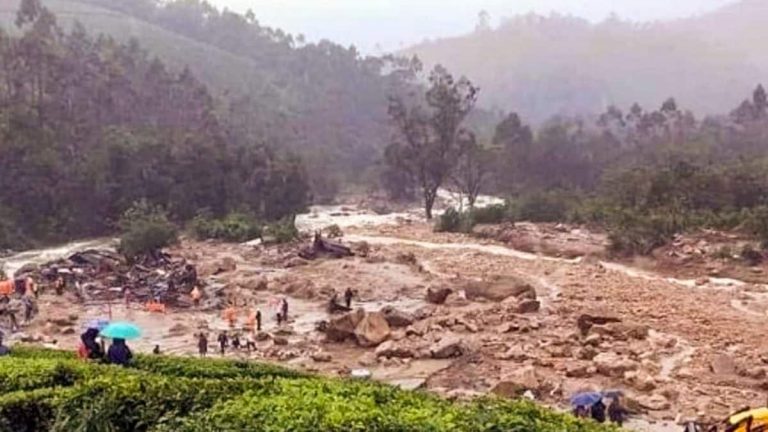After the Wayanad tragedy, the Center issued a draft notification declaring about 57,000 sq km of the Western Ghats an “ecologically sensitive area”. The area includes 13 villages in Wayanad and about 10,000 sq km in Kerala. News18 has exclusively obtained the detailed draft notification issued by the Center on July 31, which proposes to declare nearly 36 per cent of the Western Ghats as ecologically sensitive areas.
Citizens will have 60 days to submit their opinions to the Center, after which a final notification will be issued in the states or in a consolidated order, the draft notification said. An area of 56,826 sq km in six states including Maharashtra, Karnataka, Kerala, Tamil Nadu, Goa and Gujarat is proposed to be declared as “eco-sensitive area” and A series of restrictions have been imposed on business activities here. This will cover 9,994 sq km of Kerala, including 13 villages in Wayanad, the document said.
Also Read | Wayanad Connector led by Maharashtra women army personnel built in 20 hours: What is Bailey Bridge? Who were the Madras Sappers?
This is the sixth time the Center has issued a draft notification. The final draft was released in July 2022 and a committee was formed to finalize the notification in consultation with state governments.
Rampant commercialization and lack of “eco-sensitive zone” labeling are believed to be the main reasons for the Wayanad tragedy in which nearly 300 people lost their lives. According to the Centre's draft notification, the villages in Wayanad to be declared as eco-sensitive areas are: Periya, Thirunelli, Thondernad, Thrissilery, Kidanganad, Noolpuzha, Achooranam, Chundel, Kottappadi, Kunnathidavaka, Pozhuthana, Thariyod and Vellarimala.
The process of declaring the Western Ghats region spread across six states as an ecologically sensitive area has been ongoing since the high-level task force submitted its report in 2013. Activities prohibited in the “ecologically sensitive zone” include mining (with existing mines phased out within five years), new thermal power plants, “red category” industries and all new and expanded construction projects with a construction area of 20,000 square meters, the notice said.
Importance of Western Ghats
The Western Ghats is an important geology and topography on the edge of the west coast of India. It is also the source of many rivers such as the Godavari River, Krishna River, and Cauvery River. The Ghats range starts from the Tapti River in the north to Konyakumari in the south, with a total length of about 1,500 kilometers, with an average altitude of more than 600 meters, and runs through the states of Gujarat, Maharashtra, Goa, and Karnataka. 6 states including Kerala and Tamil Nadu. The high-level task force was set up during the UPA tenure to find ways to prevent further degradation of the fragile ecology of the Western Ghats, the document said.
Also Read | Wayanad Landslide: What Really Happened? Why the Western Ghats region of Kerala is prone to disasters
The high-level task force submitted its report to the Center on April 15, 2013, which has been sent to six states for their considered views on the report. The expert panel identified about 37% of the Western Ghats as ecologically sensitive areas, covering an area of 59,940 square kilometers of natural landscape of the Western Ghats. The eco-sensitive zone area proposed by the Kerala government is 9,993.7 sq km, which includes 9,107 sq km of forest area and 886.7 sq km of non-forest area, while the high-level recommended eco-sensitive zone area is 13,108 sq km. Group.
What will the ban cover?
There is a total ban on mining, quarrying and sand quarrying in ecologically sensitive areas and all existing mines shall be phased out within five years from the date of issuance of final notification or the date of expiry of existing mining leases, whichever is earlier when. New thermal power projects and expansion of existing power plants are not allowed in ecologically sensitive areas.
All new “red” industries as prescribed by the Central Pollution Control Board or the State Pollution Control Board as well as expansion of existing industries shall be prohibited and the list of “red” industries shall be prescribed by the Central Pollution Control Board. All existing “red” category industries, including healthcare institutions, should continue to remain in ecologically sensitive areas in accordance with applicable rules and regulations.
Also Read | ‘Tell him we have lost everything’: Wayanad survivor recounts spending the night with Tasker
All new and expanded housing construction projects with a construction area of 20,000 square meters and above, as well as all new and expanded township and regional development projects with a construction area of 50 hectares and above or 150,000 square meters and above, should be prohibited.
New hydroelectric projects are allowed provided that at least thirty percent of the river's ecological flow is uninterrupted during the off-season until a comprehensive study establishes a separate baseline for each project.
The document states that the provisions of this notification do not affect the ownership of properties in ecologically sensitive areas.
The state-level areas proposed by the Center for ecologically sensitive zones in the Western Ghats are: 449 sq km in Gujarat, 17,340 sq km in Maharashtra, 1461 sq km in Goa, 20,668 sq km in Karnataka, Tamil Nadu 6,914 square kilometers and India 9,993 square kilometers.
